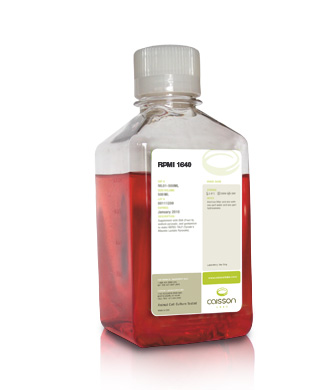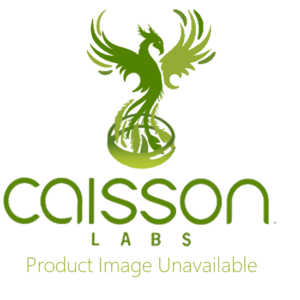Additional information
Brand
Caisson Labs
Product Storage Conditions
2 to 8°C
Product Shipping Conditions
Ambient
Product Attributes
| Weight | N/A |
|---|---|
| Dimensions | N/A |
| Format | |
| Size |
RPMI 1640 MEDIUM
RPMI 1640 is genuinely an enriched growth medium that may or may not contain L-glutamine and HEPES [4].
- RPMI 1640 was first developed in 1967 by Moore and the used term RPMI stands for “Roswell Park Memorial Institute Medium” which is a cancer treatment and leading research center in New York [1].
- RPMI 1640 represents substantially a modified form of McCoy’s 5A medium. This medium helps in the development of numerous types of cells. It was manufactured for the proliferation and rapid increase in the number of peripheral blood lymphocytes for LTC [8].
PROCEDURE:
This preparation method is for the RPMI 1640 medium that is without Glutamine, Methionine, Leucine, lysine, and sodium bicarbonate.
- Take 900ml of distilled water which comprises 90% of the required volume of water in a glass beaker. The standard temperature of the water should be carefully maintained between 15-30 degrees Celsius.
- Stir the water gently with the needed help of a stirrer. Add powdered medium in the water after agitating it well. Don’t heat the preferred medium at this point and keep it stirring until the powdered medium is dissolved in the water fully. Add a little amount of water to the empty package to pour the remaining powder into the beaker.
- Subsequently add sodium bicarbonate (2 grams if available in powder form or 26.7ml if available in liquid form for each liter of the solution prepared in the end). Again stir the specific solution until sodium bicarbonate is dissolved in it.
- Further step is to adjust the pH of the solution ranges between 0.1 to 0.3 then the required pH of the solution because it may increase after the filtration process. The pH of the solution is carefully lowered by optionally adding 1N NaOH or 1N HCL.
- Carefully add distilled water to typically reach the final volume of the solution. After the addition of distilled water, the solution is immediately sterilized. This sterilization can be accomplished by using a membrane filter with 0.22 microns’ pore size.
- This prepared solution is then stored in sterile bottles or sterile containers. The powdered form is stored under dry conditions and the liquid form is stored under dark properly maintaining the standard temperature between 2-8 degrees Celsius [12] [13].
- The components present in the powder added in the water are given at the end:
- Necessary Inorganic salts like Calcium nitrate, potassium chloride, sodium chloride, magnesium sulfate, and sodium phosphate.
- Specific Amino acids like arginine, aspartic acid, glycine, histidine, proline, serine, isoleucine, threonine, tryptophan, tyrosine, and valine, etc.
- Vitamins typically include biotin, choline chloride, aminobenzoic acid, folic acid, riboflavin, thiamine, essential vitamin B-12, and Glutathione, etc.
- Phenol Red is also present in the powder [13].
APPLICATIONS:
Following are the applications of RPMI 1640 medium that are discussed below.
- Various types of cells are produced by using RPMI medium given below in the table [8]:
| MEDIUM | TYPES OF CELLS |
|---|---|
| RPMI 1640 |
|
- RPMI medium is additionally used to properly preserve PBMC that are peripheral blood cells that naturally contain a circle-shaped single nucleus in them [10].
SPECIFICATIONS:
- Following are the specifications of RPMI medium that are discussed below [2][3][7].
| Properties | RPMI 1640 |
|---|---|
| Color |
|
| Place of Origin | United States of America |
| Appearance Form | Available in both liquid and powdery form |
| Density | 1926kg/m3 |
| pH | 7.5 – 8.5 |
| Flash Point | >60 degrees Celsius |
| Delivery Condition | Delivered at room temperature |
| Product Classification | Media |
| Storage Condition | Ranges between 2 to 8 Degrees Celsius |
| Shelf Life | Almost 36 months from the date of production |
| Moisture Content | Less than or equals to 2.0% |
| Indicator | Phenol Red |
| Additives | No sodium pyruvate additives are added |
| Odor | N/A |
| Purification | Filtered from 0.2μm filters |
| Sterility Test | It passes sterility test |
| Solubility | N/A |
| Osmolality |
|
| Endotoxin | ≤ 0.5 EU/mL |
| Analysis of amino acids by HPLC | Amino acids concentration is compatible with the formula. |
| Analysis of key elements by ICAP | Concentration of Key elements are congruous with the formula. |
HAZARDS & SAFETY:
- RPMI 1640 is not considered hazardous but it may typically cause minor irritation on prolonged exposure.
- This medium does not contain any harmful substance but in case of destructive fire, the container may burst due to elevated temperature.
- In an exceptional case of RPMI powder inhalation, promptly remove the specific victim from the affected area and gently let him breathe comfortably in the fresh air.
- In terrible cases of direct skin contact with odorless liquid or powder form of RPMI 1640, cleanse the face and affected body parts with excess water and neutral soap. Furthermore, instantly remove the contaminated clothes and wash them.
- If it is ingested mistakenly, immediately wash the victim’s mouth with sufficient water.
- No specific treatment is typically required. Promptly seek medical attention in specific cases of continuous discomfort and considerable irritation. The victim is given medical treatment scientifically based on possible symptoms [5].
- It is extremely necessary to properly use protective goggles, sterile gloves, and chemical-resistant clothes.
- After handling RPMI, must wash your hands with sufficient water and properly take care of cleanliness [6].
TERMS & DEFINITIONS:
- HEPES stands for 2-[4-(2-hydroxyethyl) piperazin-1-yl] ethane sulfonic acid. It is a buffering agent used in many chemical reactions typically occurring in cell culture medium. It is a more capable buffering agent as compared to sodium bicarbonate. It is relatively overpriced than other buffering solutions and dangerous for some cell types if present in high concentration [4][8].
- LTC stands for long-term culture. It is a specific term that represents the propagation and survival of cells for a prolonged interval of time in a cell culture medium [9].
- PBMC stands for peripheral blood mononuclear cells. These specialized cells appropriately include monocytes, dendritic cells, and lymphocytes [11].
References:
- Biocompare – RPMI
- ThermoFisher Scientific – RPMI 1640 Medium Powder
- Biological Industries – RPMI 1640 Medium
- Cytiva Life Sciences – HyClone RPMI 1640 SDS
- R&D Systems – RPMI 1640, Glutamine Plus
- BioWest – RPMI 1640 w/Glutamine w/o Sodium Bicarbonate w/o Glucose
- ATCC – RPMI 1640 Medium
- Labome – Cell Culture Media: A Review
- Springer Nature – Methodology of long-term culture of human hemopoietic cells
- Very Well Health – Overview of Myeloid Cell Line
- Miltenyi Biotec – Human Blood
- Biological Industries – Instructions for preparation of powdered medium
- Sigma-Aldrich – RPMI 1640 Medium
| Product Lot Number: |
*All products for Laboratory use only




